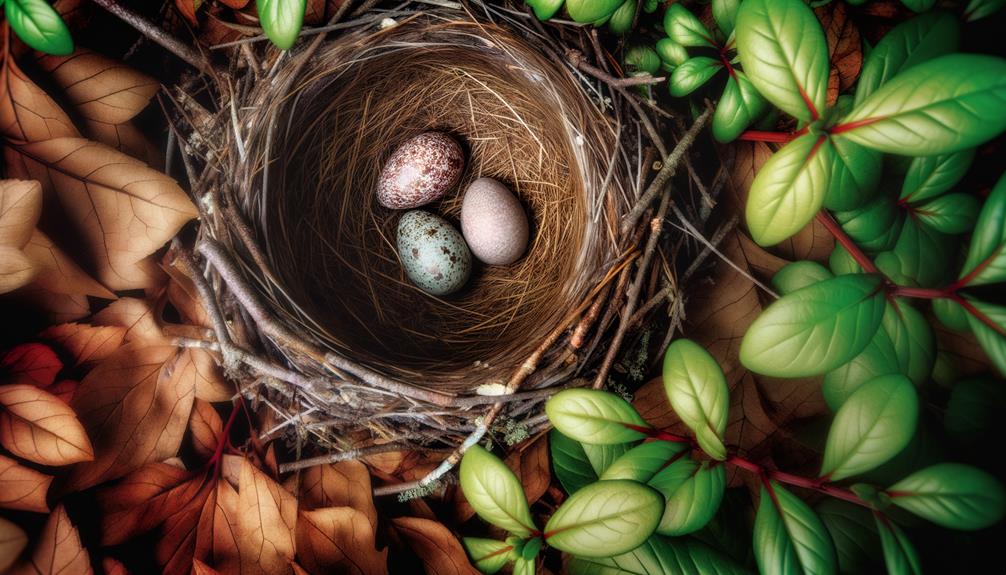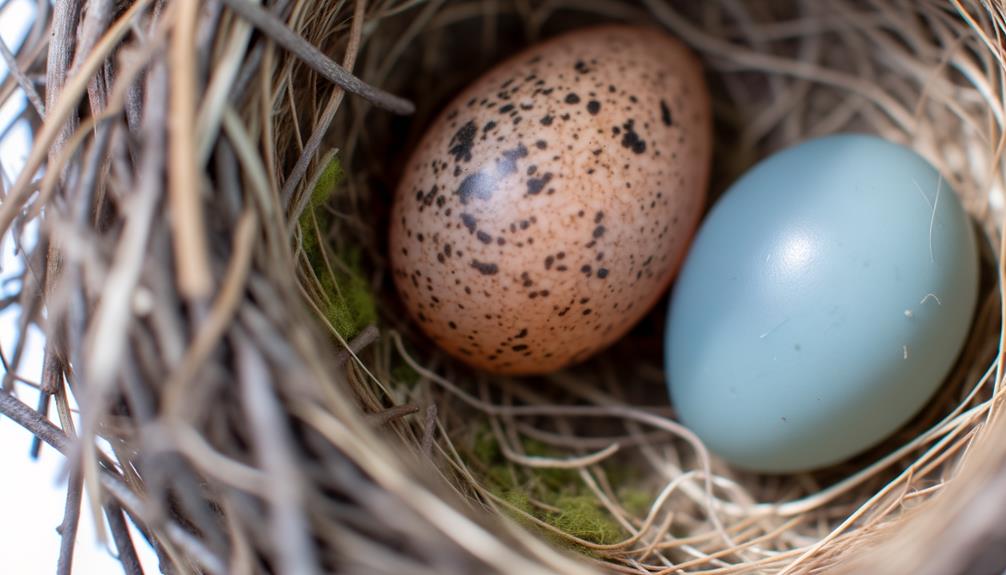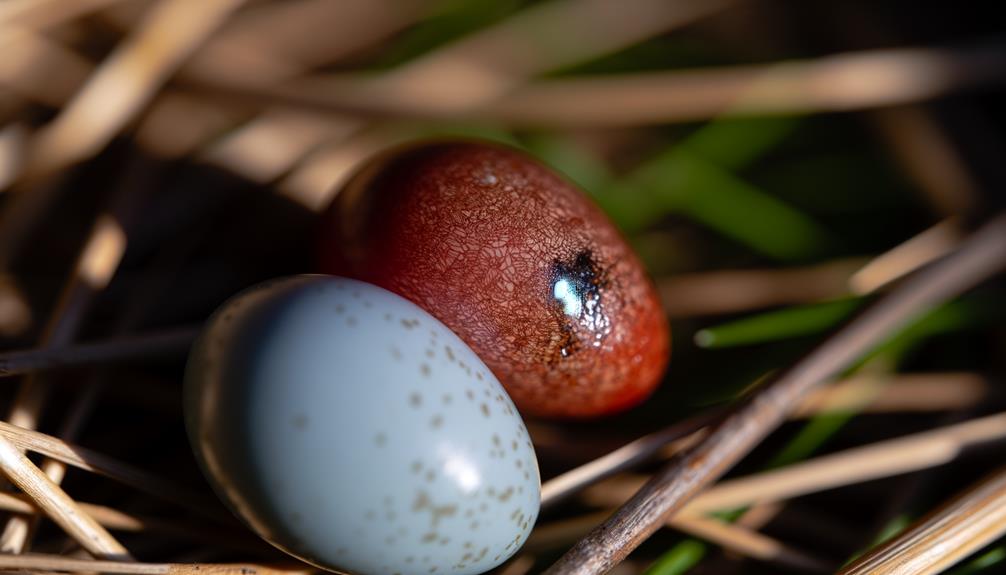7 Key Differences: Cardinal Eggs vs Robin Eggs
Comparing cardinal and robin eggs reveals intriguing differences. Robin eggs are larger, about 2.8 cm, while cardinal eggs measure roughly 2.3 cm.
Cardinal eggs are creamy white with reddish-brown speckles, blending into their surroundings, whereas robin eggs are noted for their blue color due to biliverdin pigment. Cardinal eggs have a smooth texture, unlike the rougher robin eggs, which prevents rolling.
You'll find cardinal nests in dense shrubs, while robins prefer open areas like tree forks. Both incubate their eggs for similar periods, with slight variations reflecting unique adaptations.
Discover more about these fascinating avian distinctions to understand their survival strategies.

Key Takeaways
- Cardinal eggs are smaller, measuring 2.3 cm, while robin eggs are larger at 2.8 cm.
- Cardinal eggs are creamy white with reddish-brown speckles; robin eggs are blue due to biliverdin pigment.
- Cardinal eggs have a smooth texture; robin eggs are slightly rough for grip.
- Cardinals nest in dense shrubbery; robins prefer open areas like tree forks and gutter ledges.
- Cardinals incubate eggs for 11-13 days, whereas robins' incubation period is 12-14 days.
Egg Size Comparison

When comparing the size of cardinal eggs to robin eggs, you'll notice that robin eggs are generally larger, measuring about 2.8 cm in length compared to the cardinal's 2.3 cm. This difference in size is significant when examining avian reproductive biology.
You can attribute the larger size of robin eggs to their nutritional requirements and developmental needs. A larger egg typically contains more yolk, providing additional sustenance for the developing embryo.
By understanding these measurements, you gain insight into the different life strategies of each species. Robins, with their larger eggs, invest more in individual offspring, potentially enhancing their survival rate.
In contrast, cardinals may produce more eggs, offsetting the smaller size with a greater number of potential hatchlings.
Color Differences
Observing the color differences between cardinal and robin eggs reveals a fascinating aspect of their reproductive strategies. Cardinal eggs typically exhibit a creamy white or buff background, adorned with reddish-brown speckles. This coloration helps them blend into their nesting environment, providing camouflage against predators.
In contrast, robin eggs are famous for their striking blue hue, often described as 'robin's egg blue.' This unique coloration is due to biliverdin, a pigment deposited on the eggshell during the laying process. The blue color may serve multiple purposes, including thermoregulation and signaling to the parents about the egg's health.
Shell Texture

How does the shell texture of cardinal and robin eggs differ, and what does it reveal about their nesting behaviors and environmental adaptations?
Cardinal eggs have a smooth texture, indicating a nesting environment that offers significant protection from external elements. This smoothness minimizes friction and reduces the risk of damage within the nest.
Robin eggs, on the other hand, possess a slightly rougher texture. This roughness provides added grip, essential for the open, more exposed nests robins prefer. The texture helps prevent eggs from rolling out in windy conditions.
These differences in shell texture reflect each species' unique nesting strategies and environmental adaptations, highlighting how evolution shapes even the smallest aspects of avian reproduction.
Nesting Locations
Cardinals typically build their nests in dense shrubbery or low tree branches, offering their eggs protection from predators and harsh weather conditions. You'll find these nests well-hidden and often supported by multiple twigs, grasses, and plant fibers. This strategic placement minimizes the risk of detection and maximizes the chances of egg survival.
Robins, on the other hand, prefer nesting in open areas, such as tree forks, gutter ledges, and even human-made structures. They use mud and grass to construct sturdy nests, which they often line with softer materials like feathers. Their choice of higher, more visible locations provides a broad vantage point to spot potential threats but can leave them more exposed to elements and predators.
Each species optimizes its nesting strategy for survival and reproductive success.
Incubation Period

While both cardinals and robins have distinct nesting locations, the incubation period for their eggs reveals further differences in their reproductive strategies. Cardinals typically incubate their eggs for about 11 to 13 days. During this time, the female cardinal remains on the nest, maintaining ideal temperature and humidity.
Robins, in contrast, have an incubation period ranging from 12 to 14 days. The female robin also plays an essential role, ensuring the eggs are consistently warmed. These slight variations in incubation times reflect adaptations to their respective environments and life histories.
Parental Care
Parental care in both cardinals and robins involves a careful division of labor that secures the survival and growth of their offspring. In cardinals, the male often gathers food while the female incubates the eggs and nurtures the hatchlings.
You'll notice that male robins also assist in feeding, but both parents take turns incubating and nurturing. This collaborative effort guarantees that the young receive constant warmth and nutrition.
As the chicks grow, both cardinal and robin parents continue to feed them until they're ready to fledge. By sharing responsibilities, these birds maximize their offspring's chances of thriving in a competitive environment.
This system of shared duties exemplifies an evolutionary strategy aimed at promoting the young's optimal development and independence.
Conclusion
In comparing cardinal eggs to robin eggs, you've seen the fascinating differences in size, color, and shell texture. You now understand their unique nesting habits, varied incubation periods, and distinct parental care strategies.
Isn't it incredible how these two bird species, despite their similarities, exhibit such diverse reproductive behaviors? By appreciating these nuances, you gain a deeper respect for the natural world and its intricate processes.
Nature's complexity never ceases to amaze, does it?






